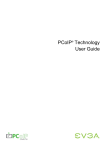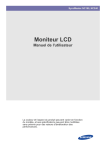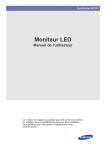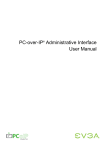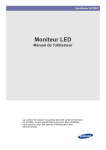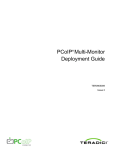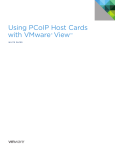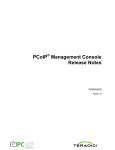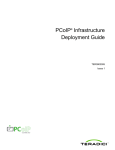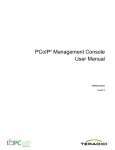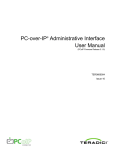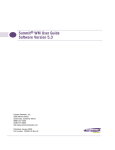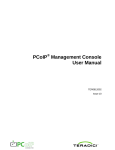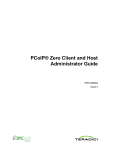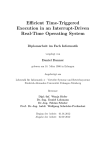Download Teradici TM User Guide
Transcript
TER0806003 PCoIP® Technology User Guide Volume I July, 2008 Issue 1 Teradici Corporation 500 – 4400 Dominion St. Burnaby, BC, Canada V5G 4G3 Abstract This document outlines PCoIP Technology user features. © 2008 Teradici Corporation PCoIP Technology User Guide (Vol I) Introduction The PC-over-IP® (PCoIP®) Technology User Guides summarize features of the PCoIP System. The following topics are covered in the PCoIP Technology User Guide Volume I: Introduction .............................................. 2 1 PCoIP Technology Overview............. 3 2 PCoIP Technology Administration..... 5 3 Deployment Options .......................... 7 4 Discovery Mechanisms....................12 5 Network Considerations ..................14 6 Bandwidth Considerations...............16 7 Imaging Considerations...................17 8 Network Characterization ................18 9 Latency Considerations ...................21 TER0806003 Issue 1 Configuration Examples Please note that this document uses the Administration Web Interface for parameter configuration examples. Refer to the Administrative Interface User Manual [1] more detail on the parameters summarized in this document. Other tools, such as the Management Console, can provide similar functionality. Refer to related tool manuals for more information. 10 USB Security ...................................22 Definitions...............................................24 References .............................................25 Revision History .....................................25 The descriptions in this document are meant to provide functional overviews with examples where relevant. It is recommended to review reference documents for more information. © 2008 Teradici Corporation Page 2 of 25 PCoIP Technology User Guide (Vol I) TER0806003 Issue 1 1 PCoIP Technology Overview This process of compression, transmission, and rebuilding the desktop occurs in a very short time, typically less than one display frame update, to ensure desktop responsiveness. The PCoIP Technology solution provides a no compromise method to remote a user’s desktop over an existing IP network. This functionality includes full DVI dual monitor video, complete USB compatibility, and full-duplex high definition audio. A PCoIP Portal can be a desktop device or be integrated into a monitor. Figure 1: PCoIP System Operating Systems and Applications The following summarizes Operating System and Application compatibility: • PCoIP Technology is operating system unaware • Extensively tested with Windows® XP® and Windows Vista® (32-bit) • PCoIP Technology does not require special drivers to be installed and uses standard USB and HD Audio device drivers Teradici’s PCoIP Technology uses networking and proprietary encoding/ decoding technology to remote connections between the Host PC/Workstation and Portal via a standard IPnetwork. Using a PCoIP Technology remote connection, a user can operate the host PC and use the desktop peripherals as if the host PC were local. PCoIP Host Processor The PCoIP Host Processor connects into the host PC or workstation via the digital video interface (DVI) and PCIe bus. The pixels from the video interface are encoded and sent to the Portal. The PCIe bus connection provides transparent bridging of USB peripherals and HD Audio using the standard USB and audio drivers provided by the OS. Prior to transmission, the PCoIP Host Processor compresses the video stream and combines the bridged audio and USB traffic. PCoIP Portal Processor At the desktop, the PCoIP Portal Processor decompresses and distributes the video, audio and USB data. In the return path, the PCoIP Portal Processor combines audio and USB peripheral data, for transmission back to the Host. © 2008 Teradici Corporation • PCoIP Technology is compatible with all PC applications as no hardware or OS changes are required in the host PC Display PCoIP Technology display attributes are: • Provides a perception free experience with low latency, full frame rate video for the same user experience as a local PC • Progressive build to deliver exact image of the rendered host display Network Related PCoIP Technology networking points are summarized: • Uses existing IP network and co-exists with existing IP data • PCoIP Technology optimizes the user experience for a given bandwidth by adaptively controlling quality and update rate of the image data, and optionally compressing the audio stream • PCoIP Technology will adapt to changing network environments and use less bandwidth when network congestion is present • PCoIP Systems can be optimized towards minimal bandwidth usage for lower bandwidth situations, e.g. corporate WAN Page 3 of 25 PCoIP Technology User Guide (Vol I) TER0806003 Issue 1 I/O The following input and output capabilities are provided with PCoIP Technology: • Fully bridged functionality for any USB device (including USB 2.0 at USB 1.1 data rates) • Full bi-directional digital audio, allowing a full multimedia experience Security PCoIP Technology features are summarized below: • The Portal is a stateless desktop appliance that has no locally stored host data or embedded Windows or Linux operating system to be compromised • Secure Host/Portal communication consists of the control data stream and the media data stream. The control data stream is secured using digital certificates for mutual authentication. The media data stream is secured using the AES encryption algorithm • USB access from the Portal is fully configurable and customizable. USB permissions may be restricted or authorized by Class or Vendor/Device ID. Any restricted USB devices will be terminated at the Portal to ensure security will not be compromised IT Support PCoIP Technology has the following IT support related features: • Neither the Host nor Portal use an embedded Windows or Linux operating system • The PCoIP Portal does not require customized drivers for peripheral support. All USB devices are transparently bridged back to the host PC or workstation • PCoIP System remotes the familiar PC user experience reducing end-user training requirements • The Portal can also be used as a universal desktop and is also capable of providing a RDP client for users that may not require the high-fidelity experience of PCoIP Technology © 2008 Teradici Corporation Page 4 of 25 PCoIP Technology User Guide (Vol I) TER0806003 Issue 1 2 PCoIP Technology Administration • Log Out Administrators can configure PCoIP Hosts and Portals via the Administrative Web Interface, PCoIP Management Console or a connection broker. The Portal can also be configured via the local Graphical User Interface (GUI) On Screen Display (OSD). • Menus: Configuration, Permissions, Diagnostics, Info, Upload These tools allow administrators to assign Host/Portal peering, view/change configuration settings and user permissions, view session diagnostics information, and view peripheral information. Each tool supports a different set of features. Consult the product documentation for more information, i.e.: • TER0606004 PCoIP Administrative Interface User Manual [1] • TER080601 PCoIP Management Console Quick Start Guide [2] • Connection broker documentation as provided by supplier • TERA1100 Portal PCoIP Processor or TERA1200 Host PCoIP Processor • Webpage summary information • Data field (with inline help when appropriate) • Apply/Cancel (Apply stores parameters in FLASH/Cancel resets values as in FLASH) Supported Web Browsers The webpage server on PCoIP Hosts and Portals has been tested and is compatible with the following web browsers: • Firefox 1.5 and 2.0 • Internet Explorer 6.0 and 7.0 Other browsers may also be compatible. Administrative Web Interface IP Address This document uses the Administration Web Interface for parameter configuration examples. This section outlines basic Administration Web Interface access. To access the Administrative Web Interface, the administrator must browse to the IP address of the Host and Portal endpoints. The IP address used depends on the method that IP addresses are determined: Accessing the Administrative Web Interface • Static IP Address: the IP address is hard coded and must be known The PCoIP Administrative Web Interface allows administrators to configure endpoints remotely using a browser. Figure 2: Administration Web Interface • Dynamic IP Address: the IP address is dynamically assigned by the Dynamic Host Configuration Protocol (DHCP) server The endpoint IP address must be known to access using the Administrative Web Interface. This can be determined from either knowledge when configuring, or discovering via DHCP server or a discover mechanism. Once the IP address is determined, it can be entered into the browser to access the Administrative Web Interface, e.g. https://192.168.1.123. Web Interface Security The web interface uses HTTP over an SSL socket (HTTPS), and cannot be accessed without an administrative password. The HTTPS connection is secured using a Teradici selfsigned certificate. The figure above shows the Administrate Web Interface with six regions highlighted; © 2008 Teradici Corporation Page 5 of 25 PCoIP Technology User Guide (Vol I) CA Root Certificate Installation TER0806003 Issue 1 Figure 3: Log In Webpage A Certificate Authorities (CA) root certificate can be installed in the internet browser to avoid the browser security warnings. Steps for installing the certificate on Internet Explorer 7 and Firefox are detailed below: Internet Explorer 7 1. Open the Tools menu and select Internet Options 2. On the Content tab, select Certificates 3. On the Trusted Root Certification Authorities tab, select Import 4. Follow the directions to import the certificate – ensure to use the Trusted Root Certification Authorities certificate store. Note: When browsing for the certificate, it may be necessary to change the file type to all files. Firefox 1. Open the Tools menu and select Options Figure 3 shows the Administrative Web Interface Log in Webpage; • Warning message displays pertinent information regarding the end point that the administrator is logging in to 2. Select the icon labeled Advanced at the top of the window • Password - allows access to the administration webpage (default value is blank, i.e. “”) 3. On the Encryption tab, select View Certificates • Idle Timeout (1 minute, 5 minutes, 15 minutes, 30 minutes, Never) 4. On the Authorities tab, select Import 5. Follow the directions to import the certificate – ensure to check the option labeled Trust this CA to identify web sites Log In The Log In page allows the administrator to securely log into the administrative webpages. © 2008 Teradici Corporation Page 6 of 25 PCoIP Technology User Guide (Vol I) TER0806003 Issue 1 3 Deployment Options reserve a range of network IP addresses for PCoIP Technology deployments. Deployment Scenarios It is recommended to use DHCP for larger deployments as the overhead of managing static IP addresses can become burdensome. If DCHP is used, it is recommended to use a discovery mechanism to avoid ‘losing’ endpoints in an IP network (see Section 4 ). There are four PCoIP Technology deployment scenarios: • Basic 1:1 – use default configuration settings to pair Host/Portal endpoints (limited to 1 Host/Portal pair on simple network) • Manual Configuration – manually enter Host/Portal pairings (less time efficient for larger deployments) • Management Console – simple tool to automate pairings and management (recommended for medium sized deployments) • Connection Broker – 3rd party management entity often with extended features (recommended for large deployments) DHCP vs. Static IP Host and Portals are configured with DHCP (Dynamic Host Configuration Protocol) enabled by default. If connected to a DHCP server, Host and Portal IP addresses will be dynamically assigned. Assigned IP address configuration information can be found in the Network Webpage (see below). When DHCP is used and default settings are used, the Host and Portal populate the DHCP server with a hostname in the form of pcoiphost-mac.domain or pcoip-portalmac.domain, where mac is the 6 octet device MAC address, and domain is the local domain. If a DHCP server is not present, the endpoints will fallback to static IP addresses (120 seconds after startup). The static IP addresses are: • Host: 192.168.1.100 • Portal: 192.168.1.50 The Host and Portal will also have the following configuration for fallback: Basic 1:1 The Host and Portal firmware IP address defaults facilitate a PCoIP Session without detailed configuration. This deployment can be used when a simple remote experience is desired with little or no endpoint management. The Basic 1:1 configuration supports the following scenarios: • Direct connection from Host to Portal with single Ethernet cable (cross over cable not required) • Connection from Host to Portal via IP switch(es) When using a direct connection without an IP switch, the Host and Portal endpoints can not be managed, for example, by the Administrative Interface. Note: Since all endpoints fallback to the static IP addresses above, no more than one Host/Portal pair can be used on the simple IP network. The above static IP addresses may also conflict with other network equipment if the fallback addresses are already in use. Manual Configuration Manual pairing of Hosts and Portals are a quick and easy way to associate PCoIP Hosts and Portals for smaller deployments. When using the Administrative Interface, the Network and Session webpages are used for manual configuration. • Subnet Mask: 255.255.255.0 • Gateway: 192.168.1.0 For small deployments, it may be preferred to use static IP addresses. Static IP addresses can also be used in a DHCP network if care is taken not to use IP addresses reserved for DHCP. If using static IP addresses, it is recommended to © 2008 Teradici Corporation Page 7 of 25 PCoIP Technology User Guide (Vol I) TER0806003 Issue 1 Network Webpage Ethernet Mode Figure 4: Network Webpage • Auto (recommended – link will auto negotiate to proper network data rate) • 10 Mbps Full-Duplex (use when network equipment, e.g. IP switch, can only support 10Mbps links) • 100 Mbps Full-Duplex (use when network equipment, e.g. IP switch, can only support 100Mbps links) Note: Improper configuration of the Ethernet Mode may result in a Half-Duplex link. PCoIP Technology is not compatible with Half-Duplex operation; a warning overlay will be shown on Portal display and the session will eventually be lost. Maximum MTU Size • See Maximum Transmission Unit in Section 5, Network Considerations) The Network webpage has 8 parameters: IP Address Fields • Enable DHCP (see DHCP vs. Static IP above) Session Webpage Figure 5: Session Webpage • IP Address (endpoint IP address must be entered for static IP addressing) • Subnet Mask (subnet mask for endpoint must be entered for static IP addressing) • Gateway (gateway must be entered for static IP addressing) • Primary DNS Server (provided by DHCP server when DHCP is enabled) • Secondary DNS Server (provided by DHCP server when DHCP is enabled) When using static IP addressing, the IP address fields can be used to specify the IP address on the Host or Portal endpoints on the network. When DHCP is used, these fields will be populated via the DHCP server. Every endpoint must have a unique IP address that will not conflict with other equipment on the network. To simplify configuration, it is recommended to keep all endpoints on the same subnet, e.g. 192.168.1.x and a Subnet Mask of 255.255.255.0. The Session webpage has 7 parameters: General session parameters: • Accept Any Peer (allows Host to accept any Portal for PCoIP Session) • Session Type (PCoIP vs. RDP) © 2008 Teradici Corporation Page 8 of 25 PCoIP Technology User Guide (Vol I) Peer Identity parameters: TER0806003 Issue 1 Figure 6: Connection Management • Identify Peer by method (use IP address for PCoIP Technology) • Peer IP Address (other endpoint IP address) • Peer MAC Address (other endpoint MAC address) Other session parameters: • Enable Auto-Reconnect (will auto connect when PCoIP Session lost) • Session Timeout (timeout to drop session when network is lost or severely congested) Manual Configuration Example This example shows manually configuring the Host and Portal pair, i.e. without the use of a Connection Management Server. The following IP and MAC addresses are used for this example: • Host: IP Address: 192.168.0.20, MAC: 0019-D2-6F-EC-6C 6. Ensure Enable Connection Management is not selected 7. Select the Session webpage from the Configuration menu Figure 7: Session Webpage (Portal) • Portal: IP Address: 192.168.0.34, MAC: 6C-EC-6F-D2-19-00 Note: For a Peer-to-Peer direct connection, it is required to know the IP and MAC addresses of the Portal and Host. Configure the Portal for peer-to-peer direct connection: 1. Open the Portal Administration Web Interface in a browser, e.g. https://192.168.0.34 2. Log in to the Portal Administration Web Interface 3. Select the Connection Management webpage from the Configuration menu 8. Select IP address next to Identify Peer by 9. Enter Host IP address in Peer IP Address, e.g. 192.168.0.20 10. Enter Host MAC address in Peer MAC Address, e.g. 00-19-D2-6F-EC-6C 11.Select Apply button to accept changes © 2008 Teradici Corporation Page 9 of 25 PCoIP Technology User Guide (Vol I) Configure the Host for peer-to-peer direct connection: TER0806003 Issue 1 Figure 9: Connect Screen 12. Open the Host Administration Web Interface in a browser, e.g. https://192.168.0.20 13.Log in to the Host Administration Web Interface 14.Select the Connection Management webpage from the Configuration menu 15. Ensure Enable Connection Management is not selected 16.Select the Session webpage from the Configuration menu Figure 8: Session Webpage (Host) 21. When connected, the Host computer is ready to use over PCoIP Management Console The Management Console (MC) is a tool to assist in the configuration of Host and Portal endpoints for medium sized PCoIP Technology deployments. The MC is a HTML based virtual appliance that is packaged with the minimum required OS. The Management Console can also be used in conjunction with a connection broker to manage the configuration of the PCoIP endpoints The expected deployment environments for the MC are: • Single subnet static IP addresses 17. Ensure Accept Any Peer is not selected 18. Enter Portal MAC address in Peer MAC Address, e.g. 6C-EC-6F-D2-19-00 • Use SLP for discovery (Management Console discovers endpoints) • DHCP w/ DNS server deployments 19.Select Apply button to accept changes • Use DNS-SRV for discovery (endpoints discover Management Console) Start the peer-to-peer session: Note: The DNS-SRV Resource Record name for the Management Console is pcoip-tool. 20.Select the Connect button to start the PCoIP session The Management Console capabilities are summarized below: Devices • Add newly discovered Host and Portal endpoints (and give endpoints a descriptive name) • Assign a endpoint to a group • View endpoint info (e.g. firmware revision, attached devices, etc) © 2008 Teradici Corporation Page 10 of 25 PCoIP Technology User Guide (Vol I) TER0806003 Issue 1 Groups • Create/edit/delete group • Assign profile(s) to group Profiles • Create/edit/delete profiles • Add configuration parameter to profile (e.g. USB authorization, bandwidth limits, etc) Peering • Peer Portal with Host Update • Update firmware to endpoint, or endpoint group Refer to the PCoIP Management Console Quick Start Guide [2] for more information on using the Management Console. Connection Brokers Connection brokers allow an administrator to manage a large PCoIP Technology deployment by dynamically assigning Host/Portal pairs. In comparison to the Administrative Web interface or Manage Console, connection brokers often provide a deeper feature set for defining user and endpoint policies, for example: • Host Pooling • Defining sessions for users • Policies based on User ID/location Connection brokers are server based to allow for continuous monitoring of Host and Portal endpoints. The Management Console may be used simultaneously with a connection broker. If using a connection broker, refer to documentation provided by connection broker supplier. © 2008 Teradici Corporation Page 11 of 25 PCoIP Technology User Guide (Vol I) 4 Discovery Mechanisms TER0806003 Issue 1 Figure 10: Discovery Webpage Host and Portal pairs must be associated with one another before a PCoIP Session can be initiated. The first step is to determine the network location of the endpoints. Although this can be done manually, it is often more convenient in larger PCoIP Technology deployments to automatically discover Host and Portal endpoints attached to the network. In order for the Connection Management Server (CMS) or other management entity, e.g. connection broker, to discover the Host and Portal endpoints, endpoints may use a combination of: The Discovery webpage has four fields: • DNS-SRV Resource Records discovery (DNSSRV RR) • Enable SLP Discovery (see Discovery Using Service Location Protocol below) • SLP discovery • Enable Host Discovery (allows Portal to use SLP Discovery) The discovery mechanisms available with PCoIP Technology may be used with or independent of each other. • Enable DNS SRV Discovery (see Discovery Using DNS-SRV Resource Records below) SLP may be used by the Host and Portal endpoints without a management entity (e.g. Management Console or connection broker). See the Service Location Protocol section below for more details. • DNS SRV Discovery Delay (configures delay after final domain name variation for DHCP options 15 before beginning DHCP options 12 name variations - see RFC 1497 for more information) It is recommended that deployments use DNSSRV discovery as the preferred method to discover Host and Portal endpoints. See the DNS-SRV section below for more details. Discovery Using DNS-SRV Resource Records The sections below summarize features for each discovery mechanism. Note: An administrator should have a good understanding of networking before implementing discovery mechanisms. Configuring Discovery The Discovery webpage is used to enable the discovery mechanisms. Host and Portal endpoints can be configured to use discovery mechanism that utilizes DNS-SRV Resource Records (refer to RFC 2782). Refer to the Management Console [2] and/or connection broker [3] documentation for configuration detail. Similar to other discovery mechanisms, DNSSRV discovery allows the management entiry to discover the endpoint, without prior endpoint configuration of the Connection Manager IP Address/DNS Name parameter. In other words, DNS-SRV discovery operates independently of the Connection Manager IP Address/DNS Name value. If the Connection Manager IP Address/DNS Name value in the endpoint becomes stale, DNS-SRV discovery continues to work and the new CMS can discover the endpoint.. Benefits DNS-SRV discovery has the ability to have redundant backup CMS hosts. DNS-SRV Resource Record can have multiple CMS servers with different priorities and weights, so © 2008 Teradici Corporation Page 12 of 25 PCoIP Technology User Guide (Vol I) endpoints can advertise to the primary CMS first, and in the event of a transmit failure, advertise to a secondary CMS. Unlike Service Location Protocol, DNS-SRV discovery does not use multicast IP traffic, and as a result DNS-SRV discovery works across subnets. Typically routers, by default, block multicast IP traffic so the CMS cannot use SLP to discover endpoints located on different subnets. DNS-SRV provides a standardized approach for the endpoint to query the DNS server for a CMS service. Requirements DNS-SRV discovery requires the following: • DNS zone data must have a DNS-SRV RR with the format described by RFC 2782: _Service._Proto.Name TTL Class SRV Priority Weight Port Target Where: _Service=_pcoip-broker, _Proto=_tcp, Name = hierarchical domain name • Endpoint must have access to a DHCP server in order to get the domain name and hostname (to get DHCP options 15 and 12 respectively) TER0806003 Issue 1 • Host and Portal advertise services so that the CMS can discover the endpoint The endpoint uses the Service Location Protocol (SLPv2) as defined in RFC2608. The endpoint advertises a service to either a SLP directory agent or an endpoint/CMS (if a Directory Agent is not present). SLP over Multiple Subnets When endpoints, CMS (if present), and Directory Agent (if present) are on the same subnet, SLP uses multicast/broadcast SLP messaging to register and discover service locations. However when any endpoint or CMS is on a different subnet, routers must be configured to allow packets destined for the SLP multicast group 239.255.255.253 to pass through. Multicast reduces network congestion by directing SLP messages to endpoints registered with the standard SLP multicast group. The endpoint uses the IGMP (Internet Group Management Protocol) to ‘join’ the standard SLP multicast group. Packets sent to IP address 239.255.255.253 are multicast to the endpoints registered with the group. A User Agent multicasts a service request (to the SLP multicast group) and a Service Agent responds via a unicast connection. If the PCoIP System is deployed over multiple subnets, the multicast enabled routers must not filter packets destined for the SLP multicast group • DHCP server must support either DHCP options 12 (hostname), 15 (domain name), or both. If the DHCP server only supports DHCP options 12, the hostname string must contain the domain name. Discovery Using Service Location Protocol The endpoint can be configured to use Service Location Protocol (SLP) discovery. Depending on the deployment, the endpoint uses SLP discovery as follows: Unmanaged deployments: • Host and Portal advertise services so that another network SLP-aware entity can discover the endpoint • When host discovery is enabled on Portal, Portal dynamically discovers Hosts Managed deployments: © 2008 Teradici Corporation Page 13 of 25 PCoIP Technology User Guide (Vol I) 5 Network Considerations TER0806003 Issue 1 Figure 11: Network Webpage (MTU) PCoIP Technology uses routable IPv4 network packets. By default, the endpoints are configured for use in an enterprise network with minimal setup. This section outlines points that may affect some IP networks. The bulk of network traffic between the PCoIP Host and Portal is comprised of video, USB and audio media and is carried in IPsec-ESP packets. Other network protocols are used for configuration and control (see port numbers below). Full-Duplex Networks PCoIP Technology requires Full-Duplex Ethernet links. Older communication equipment including hubs and Half-Duplex switches are not appropriate for PCoIP Technology deployments due to the limited effective bandwidth. MTU Parameter: PCoIP Technology TCP/UDP Ports • Default MTU size is 1400 bytes, can be configured from 500 to 1500 bytes Table 1 summarizes the TCP and UDP ports used in PCoIP Systems. For networks with firewalls between the Host and Portal, the following ports must be open. Table 1: PCoIP Technology TCP/UDP Ports Port Port Number TCP Ports 21, 51, 80, 427, 443, 8000, 50000, 50001 UDP Ports 53, 67, 68, 427 Maximum Transmission Unit The PCoIP Technology firmware allows for configuration of the Maximum Transmission Unit (MTU) of the data packets. This allows for customization of MTU size for the network equipment used. See Packet Fragmentation below. The MTU parameter can be set using the Network webpage. NAT Traversal The PCoIP Technology data packets are IPSec encrypted and do not have any port numbers external to the encryption. As a result, the packets are not compatible with networking equipment (e.g. routers) that implement Network Address Translation (NAT). NAT networking gear can be used when PCoIP Technology network traffic is encapsulated in a tunneling protocol. This tunneling can be achieved using a hardware VPN link (see VPN section below). Packet Loss and Ordering PCoIP Technology is resilient to packet loss; however, performance will degrade as a function of the loss rate. Packet loss should be constrained to less than 0.1% for a good user experience. Packets that are reordered by network equipment are treated as lost. PCoIP Technology transfer and loss statistics are available on the Administration Web Interface, are made available to connection brokers and are also provided via an SNMP MIB. © 2008 Teradici Corporation Page 14 of 25 PCoIP Technology User Guide (Vol I) TER0806003 Issue 1 Packet Fragmentation PCoIP Technology data packets cannot be fragmented by network equipment. To avoid fragmentation the MTU can be set to the largest MTU supported by all the network equipment across the network path. See the Maximum Transmission Unit section above for configuration information. Virtual Private Networks A Virtual Private Network (VPN) tunnel can allow PCoIP Technology traffic to traverse Firewalls and network equipment performing NAT. PCoIP Technology is compatible with available hardware VPNs. For port and MTU configuration, refer to PCoIP Technology TCP/UDP Ports and Maximum Transmission Unit sections above. Figure 12: Example VPN Network Datacenter User Desktops Hardware VPN Internet Blade PC’s or Workstations © 2008 Teradici Corporation Hardware VPN Desktop Portal Page 15 of 25 PCoIP Technology User Guide (Vol I) 6 Bandwidth Considerations Bandwidth usage in PCoIP Systems varies depending on the use category and desired user experience. This section outlines some bandwidth configuration considerations. TER0806003 Issue 1 Bandwidth Priorities PCoIP System bandwidth priorities are: • USB and Audio are given priority • Imaging uses remaining available bandwidth Bandwidth Configuration Bandwidth Usage Bandwidth webpage parameters: PCoIP Systems have four general sources bandwidth usage: • Portal webpage defines Portal → Host • Host to Portal imaging data – dominates bandwidth • Bandwidth range: 3 to 220 Mbps • HD Audio streams – typically significantly lower bandwidths Figure 13: Bandwidth Webpage • Host webpage defines Host → Portal • USB bridging – typically significantly lower bandwidth • System management – relatively negligible bandwidth Imaging Bandwidth As imaging dominates bandwidth usage, it is important to note these characteristics: • Only changing screen areas generate imaging related network traffic The Bandwidth webpage has two fields: • Low resolution displays have fewer possible pixel changes resulting with less bandwidth usage than high resolution displays Device Bandwidth Limit • Worst case: high resolution, high contrast, full screen moving image (e.g. video games & real-time 3D rendering) • ‘0’ allows PCoIP Technology to adjust for congestion; no congestion, no limit • Limits maximum peak; only uses up to limit (or less during periods of network congestion) • Configurability to reduce bandwidth requirements vs. user experience • Recommended to set to link limit (minus 10% headroom) of network connected to Host and Portal • Long periods with no pixel changes result in low average network traffic Note: Device Bandwidth Limit is applied immediately after selecting Apply Audio and USB Bandwidth Device Bandwidth Target HD audio and USB considerations: • Soft network limit during congestion • Audio compression can be enabled to reduce bandwidth during congestion • During congestion, device bandwidth rapidly reduced to target; then slowly • USB data is not compressed • Allows for more even distribution of user bandwidth on congested trunks • USB bulk data transfer (e.g. USB FLASH drive) is often in opposite direction (i.e. Portal → Host) to imaging (i.e. Host → Portal) and therefore is not additive © 2008 Teradici Corporation • Should understand network topology well before setting to non-zero value Note: Device Bandwidth Target is applied on next PCoIP Session after selecting Apply Page 16 of 25 PCoIP Technology User Guide (Vol I) 7 Imaging Considerations Configuration of imaging parameters has a large impact on the user experience and bandwidth usage in PCoIP Systems. This section reviews some imaging configuration considerations. Imaging Configuration Image webpage allows configuration of imaging parameters to balance: • Preference to have lower quality images at higher frame rate, vs. • Preference to have higher quality images at a lower frame rate Figure 14: Image Webpage TER0806003 Issue 1 • Changes the network bandwidth peaks required by a PCoIP Session by limiting initial quality on the changed regions of the image • Selecting towards Reduced will reduce the image quality of content changes and decrease peak bandwidth requirements • Selecting towards Perception-Free will increase the image quality of content changes and increase peak bandwidth requirements • Unchanged regions of image will progressively build to lossless state regardless of setting • Maximum Initial Image Quality must be set greater than or equal to Minimum Image Quality • It is recommended to set Maximum Initial Image Quality to 90 or lower to best utilize the available network bandwidth The Image webpage has two fields: Minimum Image Quality: • Allows balancing between image quality and frame rate for limited bandwidth scenarios • Selecting towards Reduced allows higher frame-rates (and lower quality display) when network bandwidth is constrained • Selecting towards Perception-Free allows higher image quality (and lower frame rates) when network-bandwidth is constrained • When network bandwidth is not constrained, PCoIP System will maintain maximum quality regardless of setting • Must be set less than or equal to Maximum Initial Image Quality Maximum Initial Image Quality: © 2008 Teradici Corporation Page 17 of 25 PCoIP Technology User Guide (Vol I) TER0806003 Issue 1 8 Network Characterization • Plan for worst-case network congestion during simultaneous worst-case users This section outlines basic network impact for PCoIP Technology implementations. • Minimum Image Quality and Maximum Initial Image Quality settings define user experience during the instances of congestion (see Section 7 Imaging Considerations) Note: This base analysis is conservative and weighted towards a perception free experience. Administrators must study use case(s) typical for their deployment and adjust network requirements accordingly. User Categories It is important to understand the user experience desired to determine the network footprint required. The following are generalized user categories from lowest to highest bandwidth utilization: • Task Worker - Primarily text entry into forms • Knowledge Worker – Uses standard office applications such as word processing, spreadsheets, and presentation tools. Uses web, reads and writes emails, etc. • Performance User/Basic CAD – Similar to Knowledge Worker with the exception of occasional use of high-end visual applications, and may perform analysis on static images • Video Editing – Similar to performance user, but requires consistent high-quality multimedia playback • Extreme User – Discerning users of high-end visual applications such as 3D CAD rendering, video editing or animation. Typically content has a higher resolution and the user performs technical analysis by dynamically manipulating images (CAD design, healthcare MRI/CAT scan analysis etc) The Enterprise Networks White Paper [3] also provides a primer on the network requirements for PCoIP Technology deployments. Bandwidth Planning Bandwidth planning requires understanding the desired user experience. The following are conservative considerations for bandwidth planning: • For conservative planning, plan using the bandwidth a user needs during a worst case congestion period • Minimum acceptable frame rate is 10-30 fps for most users Planning Basics The following generalities are provided as a starting point for planning network requirements of a PCoIP System: • More graphically demanding applications command higher bandwidth usage than less graphically demanding applications • User applications and scenarios vary • Users will likely not require peak bandwidth all at the same time • Some users are more critical then others – acceptable performance is subjective • If the network is rarely congested, no one will experience degradation Conservative Planning To ensure a perception free experience, it is recommended to begin with conservative measures when planning the required network for PCoIP Technology: • Provision network with the sum of all Planning Bandwidths plus 10% • Knowledge Workers and below can use 100 Mbps connections, while demanding user categories should use 1 Gbps connections to take advantage of available bandwidth, Once a baseline is established, there are more application characteristics to consider: • Few applications can consistently produce full screen changes all the time • Video has durations of low bandwidth • Graphic screen savers will consume bandwidth • Conservative, worst-case scenario is continuously changing full screen © 2008 Teradici Corporation Page 18 of 25 PCoIP Technology User Guide (Vol I) TER0806003 Issue 1 Addressing Fairness 20 Mbps Device Bandwidth Target One issue in network usage is fairness, or the fair sharing of the network resources. Without control, some users may end up getting a larger share of network bandwidth than other users. Now each user has the following bandwidth configuration: The administrator can improve fairness by configuring Device Target Bandwidth, e.g. through the Administrative Interface. • Device Bandwidth Limit: 0 Mbps • Device Bandwidth Target: 20 Mbps Figure 16: 20 Mbps Device Bandwidth Target Target Bandwidth Example This section outlines a simplified example of configuring Device Bandwidth Target to improve fairness. The following parameters are considered: • Four users sharing a 100 Mbps link • All users constantly active using graphically intensive applications (approx. 60% of display changing) • Device Bandwidth Limit set to 0 Mbps (i.e. PCoIP Technology adjusts bandwidth usage depending on congestion to allow users to take advantage of unused bandwidth when available) In the figure above, we now see • Clamps at 20 Mbps • No one more than 20% of the time below “fair” usage 25 Mbps Device Bandwidth Target • Bandwidth measured over 60min at 5sec intervals The bandwidth parameters are now updated so each user has the following bandwidth configuration: • Device Bandwidth Target settings: No (0 Mbps, 20 Mbps, 25 Mbps and 30 Mbps • Device Bandwidth Limit: 0 Mbps No Device Bandwidth Target Figure 17: 25 Mbps Device Bandwidth Target • Device Bandwidth Target: 25 Mbps The figure below shows 4 users sharing a 100 Mbps link. Each user has the following bandwidth configuration: • Device Bandwidth Limit: 0 Mbps • Device Bandwidth Target: 0 Mbps Figure 15: No Device Bandwidth Target With Device Bandwidth Target set to 25 Mbps, we see: • 25 Mbps per connection is the network capacity (100 Mbps / 4 users) • Congestion management keeps bandwidth tight around 25 Mbps From the figure above, we can see: • Some dips down to 19 Mbps • Many dips below 17 Mbps • Grossly “unfair” at times as some users always ‘stuck’ with lower bandwidths © 2008 Teradici Corporation Page 19 of 25 PCoIP Technology User Guide (Vol I) TER0806003 Issue 1 30 Mbps Device Bandwidth Target Device Bandwidth Limit Finally, each user has the following bandwidth configuration: The above example has the Device Bandwidth Limit configured to allow the PCoIP Processors to manage bandwidth throttling (i.e. configured to 0 Mbps). • Device Bandwidth Limit: 0 Mbps • Device Bandwidth Target: 30 Mbps Figure 18: 30 Mbps Device Bandwidth Target This configuration is recommended for most usage cases unless the administrator requires limiting bandwidth usage. Examples scenarios are networking equipment that is unreliable when fully utilized or the requirement to put strict limits on user bandwidth usage. Constrained Network Effects With Device Target Bandwidth set to 30 Mbps, we now have: • Device Target Bandwidth set too high • PCoIP Technology congestion management still operates, but is not optimized • Fairness better than with no target • Some dips down to 18 Mbps Bandwidth Optimization The example above shows a simplified example to understand bandwidth parameters. In an environment that does not provide adequate bandwidth, PCoIP Technology will gracefully adjust. Depending on the resulting network congestion, some artifacts may be present, e.g.: • Image smearing and blocking artifacts may be present • Less responsive user interface, e.g. slower window movements with mouse, generally due to a decrease in the imaging update rate It is recommended to set the bandwidth limit at or below the limiting network link that the PCoIP data traverses. For example, if the PCoIP data traverses a 100 Mbps link (e.g. link to the desktop), the limit should not exceed 100 Mbps. Device Bandwidth Target The bandwidth usage data above shows that for this simplified example, the PCoIP Systems are optimized when setting the Device Bandwidth Target to ensure fairness for all users. In this example the network link is 100 Mbps for four users, so the fair Device Bandwidth Limit is 25 Mbps (100 Mbps / 4 users). It must be noted that this example had four users continually active. This is not a realistic scenario, as even extremely active users will not have constantly changing displays (e.g. pause to study detail). It is reasonable to assume that each user would have periods of low bandwidth usage. This example also is a bit backwards as we begin with the network capacity (100 Mbps) and then find a ‘fair’ usage scenario. Although this was done to illustrate the bandwidth configuration features, a better strategy would be to determine the required bandwidth to meet users experience expectations and work towards the network capacity required. © 2008 Teradici Corporation Page 20 of 25 PCoIP Technology User Guide (Vol I) TER0806003 Issue 1 9 Latency Considerations Desired Network Attributes With any network, there are latency effects to be addressed. The following are latency effect considerations for PCoIP Technology deployments: The desired network attributes to minimize latency effects are: • Latency effects are subjective and affect response (e.g. mouse movement) • Latency due to length of physical medium (i.e. speed of light of copper/fiber) and switch hops • Additional latency due to OS (e.g. 40-50 ms for Windows) • High bandwidth • Low error rate • Minimized data path/network hops Networks with less desirable network attributes will result in decreased performance, i.e. decreased mouse and display responsiveness. USB Latency Performance The table below outlines latency effects examples based on critical user evaluation. User tolerance levels for latency vary widely. USB performance can vary over latency for the various transfer types: Table 2: Latency • Isochronous – may notice delay or loss of data (e.g. video data lost on a webcam) 1 Network Latency Approx. Distance Example 2 Observations 0-30 ms Campus/Metro/ Inter-city Perception free to average user (0-1500 km) 40-60 ms 60-100 ms > 100 ms Inter-city/Intracountry (1500-2500 km) Minimal latency perceived, e.g. ‘heavier’ than usual mouse pointer/windows, but very usable Intra-country/ Intercontinent Sluggish mouse and windows (2500-5000 km) Some audio/ video dropouts Inter-continent/ Overseas Slow mouse and windows (> 5000 km) Audio/video dropouts Notes: 1. High bandwidth, low error network • Interrupt – may delay device response (e.g. slow keystrokes from keyboard) • Bulk – may notice slower data transfer (e.g. slower USB FLASH drive) Minimizing Latency Effects The following are suggestions for extreme long distances, non-enterprise networks or less than desirable networks to minimize latency effects: • Use graphically less demanding computer applications and set user expectations accordingly • For bandwidth constricted environments, configure Device Target Bandwidth and Device Bandwidth Limit parameters to limit bandwidth usage to minimum required (see Section 6 Bandwidth Considerations) • Configure Image settings to minimum image quality required (see Section 7 Imaging Considerations). 2. Examples given are based on subjective critical analysis Note: As with bandwidth considerations, these latency observations are subjective and biased towards a perception free experience. Administrators must study use case(s) typical for their deployment and adjust user expectations accordingly. © 2008 Teradici Corporation Page 21 of 25 PCoIP Technology User Guide (Vol I) 10 USB Security TER0806003 Issue 1 Figure 21: Selecting the Printer PCoIP Technology provides granular security control to authorize and unauthorize USB devices. Note: The USB security is applied in the following priority order (Unauthorized Vendor ID/Product ID has highest priority): 1. Unauthorized Vendor ID/Product ID 2. Authorized Vendor ID/Product ID 3. Unauthorized Device Class/Sub Class/Protocol 4. Authorized Device Class/Sub Class/Protocol Following are three USB authorization/unauthorization examples: • Authorize specific class of printers • Authorize specific vendor/product ID combination • Unauthorize mass storage devices Authorizing USB by Class 4. If all printers were to be authorized, the sub class and protocol should be left as Any. In this example, only printers supporting a specific protocol are authorized. Select Printer. Figure 22: Selecting the Sub Class 1. In the Authorization section, select Add new button. Figure 19: Add new Button 5. Finally the protocol can be selected. Here the desired IEEE 1284.4 compatible bidirectional protocol is chosen, and the USB permissions entry is complete. 2. When the entry fields expand, select the entry type. As the intent is to authorize device class, select Class. Figure 23: Selecting the Protocol Figure 20: Selecting the Class Entry Type 3. Next the Device Class must be selected. Select Printer. © 2008 Teradici Corporation 6. Select Add to add changes and Apply to save the changes to FLASH to complete the configuration. Page 22 of 25 PCoIP Technology User Guide (Vol I) Figure 24: Printers Authorized TER0806003 Issue 1 De-authorizing USB by Class Example 1. In the De-authorization section, select Add new button. Authorizing USB by Vendor/Product ID Figure 29: Add new Button 1. In the Authorization section, select Add new button. Figure 25: Add new Button 2. When the entry fields expand, select the Class entry type. Figure 30: Selecting the Class Entry Type 2. When the entry fields expand, select the ID entry type. Figure 26: Selecting the Class Entry Type 3. Next the Device Class must be selected. Select Mass Storage. Figure 31: Selecting Mass Storage 3. Enter the USB device Vendor ID and Product ID. Figure 27: Entering Vendor ID and Product ID 4. Select Add to add changes and Apply to save the changes to FLASH to complete the configuration. 4. Select Add to add changes and Apply to save the changes to FLASH to complete the configuration. Figure 28: Vendor ID and Product ID Authorization Figure 32: Mass Storage De-authorized © 2008 Teradici Corporation Page 23 of 25 PCoIP Technology User Guide (Vol I) TER0806003 Issue 1 Definitions 3D 3 Dimensional NAT Network Address Translation CAD Computer Aided Design OS Operating System CMS Connection Management Server (an external 3rd party management entity capable of managing Hosts and Portals) OSD On Screen Display PC-over-IP Personal Computer over Internet Protocol Technology DA Directory Agent PCoIP Host Host side of PCoIP System DHCP Dynamic Host Configuration Protocol PCoIP Portal Portal, or client, side of PCoIP System DNS Domain Name System PCoIP DNS-SRV Domain Name System Service Record Personal Computer over Internet Protocol Technology RDP Remote Desktop Protocol fps Frames per Second (display data frame update rate) RFC Request for Comments (internet standards documents) FQDN Fully Qualified Domain Name SA Service Agent GUI Graphical User Interface presented by the TERA1100 On-Screen Display when not operating in a PCoIP Session SLP Service Location Protocol SNMP Simple Network Management Protocol, (used to monitor network devices) SSL Secure Socket Layer (security protocol) TERA1100 Teradici device supporting PCoIP Portal, or client, functionality TERA1200 Teradici device supporting PCoIP Host, functionality UA User Agent VPN Virtual Private Network WAN Wide Area Network (e.g. extended corporate continental network HTML HyperText Markup Language IPsec-ESP Internet Protocol securityEncapsulated Security Payload IP Internet Protocol IPv4 Internet Protocol version 4 (dominant network layer protocol on the internet) MAC Media Access Control (MAC address is unique hardware identifier) MC Management Console MIB Management Information Base (used by SNMP) MTU Maximum Transmission Unit © 2008 Teradici Corporation Page 24 of 25 PCoIP Technology User Guide (Vol I) TER0806003 Issue 1 References Revision History 1. TER0606004, PC-over-IP Administrative Interface User Manual Issue 3, May 2008 Version Date Description 1 Jul, 2008 Initial release 2. TER0806011, PCoIP Management Console Quick Start Guide Issue 1, July 2008 3. TER0806005, PC-over-IP Technology on Enterprise Networks, Teradici White Paper, July 2008 © 2008 Teradici Corporation Page 25 of 25

























